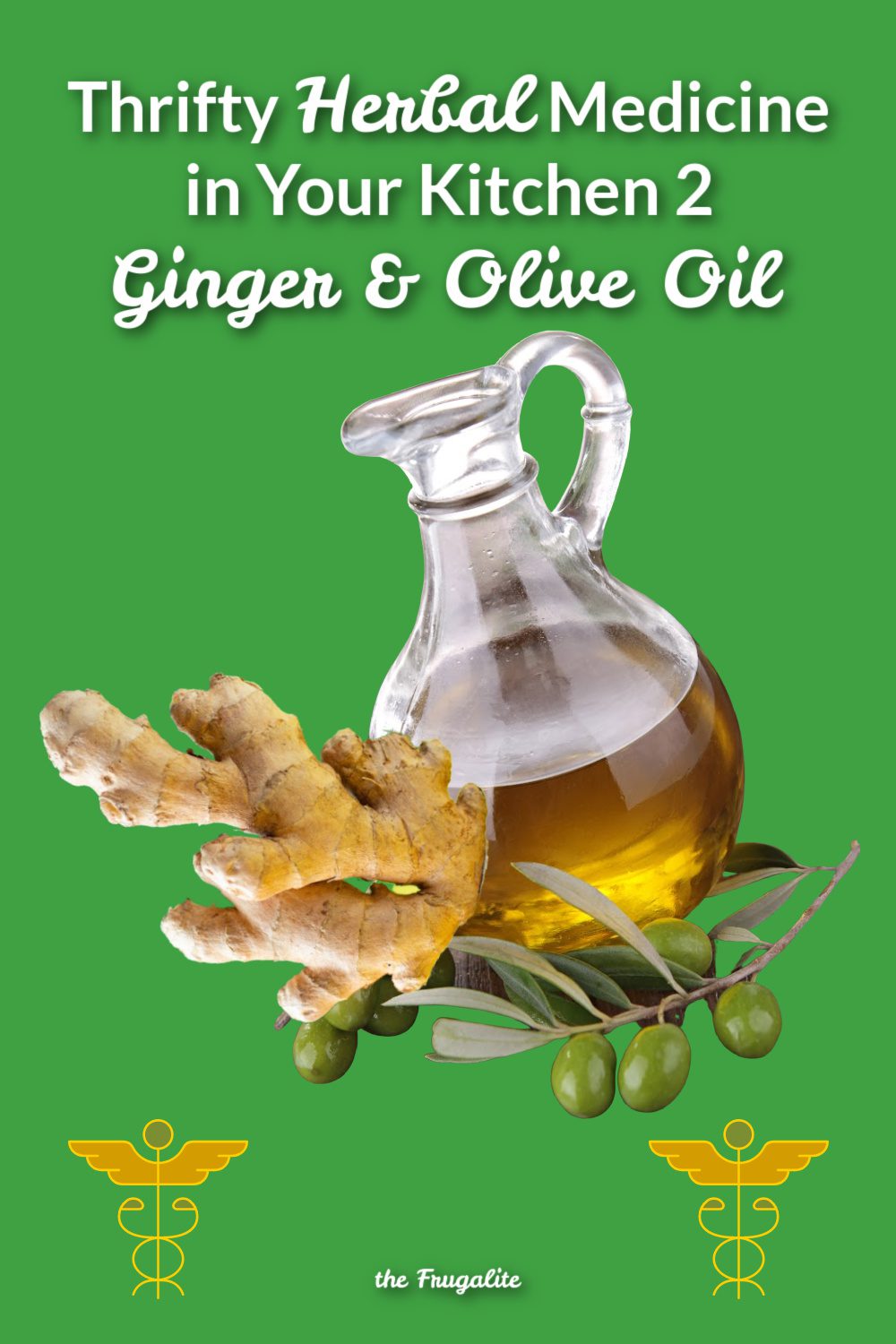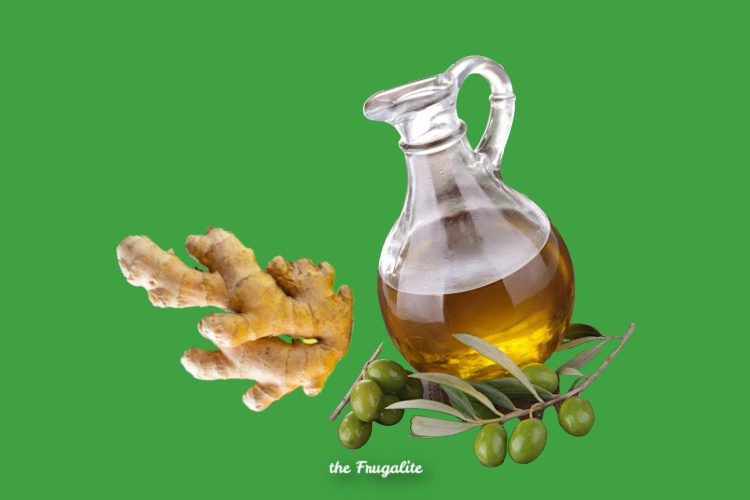(Psst: The FTC wants me to remind you that this website contains affiliate links. That means if you make a purchase from a link you click on, I might receive a small commission. This does not increase the price you’ll pay for that item nor does it decrease the awesomeness of the item. ~ Daisy)
In the first Thrifty Herbal Medicine in Your Kitchen article, I shared the amazing benefits of Garlic and Turmeric. In this article, I continue to share some of my experiences with these anti-viral foods and readily available herbs: Ginger and Olive Oil.
John Heinerman was a medical anthropologist who has traveled to over 30 countries to collect information about countless herbs and how they are used to heal. In the style of Heinerman, I will share personal stories about two of my thrifty herbal favorites with you. You may have some of these in your kitchen cupboard right now. I hope my stories might inspire you to see them in a different light.
DISCLAIMER: This article states the opinions and experiences of the author and does not constitute medical advice. The FDA has not tested these claims. Due to the risk of allergic reactions and interactions between herbal medicines and prescription medicines, always consult with your own physician before taking any herbal medicines.
Ginger
I have always found that my constitution runs a bit on the cold side. What do I mean by this? My feet are often cold, especially in the winter. I don’t like being cold. Ginger is considered a warming herb in Ayurvedic medicine, an ancient branch of medicine that originated in India. I find ginger wonderfully warming and start to crave it in early fall as the temperature begins to dip.
The main way I take my ginger is as tea. I sometimes buy organic dried ginger tea in bags. When I have some fresh ginger root on hand, I slice an inch of the root and crush it a bit to bring the flavors out. Then, scoop it into a good-sized mug and pour in some boiling water. I steep either of these for about 10 minutes. If I feel like it, I add half a teaspoon of honey. Mmmmm! If I’m a bit stuffed up, I breathe in the tea in between sips. I find the effect on my throat and nose both soothing and invigorating.
While I like my ginger tea to warm myself up, you can also use it to settle digestive upsets or nausea. In fact, ginger is so effective at relieving nausea that it is the main ingredient in a well-known over-the-counter anti-motion sickness remedy.
How does ginger work against viruses, you might ask?
According to some theories, its warming action is protective because it cleanses the body’s systems, like the lymphatic system, and helps break down and remove toxins. In fact, a 2013 study in the Journal of Ethnopharmacology found that fresh ginger had anti-viral properties against the Human Respiratory Syncytial Virus, which causes respiratory tract infections. The fresh ginger inhibited the virus’ ability to attach itself and stimulated the mucosal cells to stimulate a potentially anti-viral compound.
Wow! This puts another spin on my cup of ginger tea. The anti-viral benefits were found only with fresh ginger. I am going to keep this in mind in the future. If you want to try ginger other ways, you could also make some chai tea or enjoy a delicious chickpea curry.
Olive Oil
The benefits of what is called a Mediterranean diet are becoming more researched and popularly known these days. Studies demonstrate a wide range of benefits, including the reduction of some kinds of cancer, prevention of cardiovascular diseases, and even a “lower risk of mental disorders, including cognitive decline and depression.”
Who is the star of the Mediterranean diet, you might ask? In my opinion, it is olive oil, which is considered the main source of fat in this diet.
Olive oil contains what are called monounsaturated fats. According to the American Heart Association, these are important to health because they “can help reduce bad cholesterol levels in your blood, lowering your risk of heart disease or stroke. They also provide nutrients to help develop and maintain your body’s cells.” These nutrients in olive oil are important for its anti-viral properties, including plant compounds called oleuropein and hydroxytyrosol, “which offer viral protection in the form of antioxidative and anti-inflammatory factors. Of note, these properties are strongest in extra virgin olive oil.”
How can I add olive oil to my diet?
Now, I don’t necessarily recommend making tea out of olive oil or drinking it neat. However, there are many ways someone accustomed to a North American diet can add some olive oil. I started frying my eggs in olive oil many years ago in my cast iron frying pan. I used to fry my eggs in butter and, at first, I was concerned I wouldn’t like it. I still fry my eggs in olive oil and find them delicious. There is a wonderful side effect that olive oil seasons your cast iron frying pan so well.
In the summer, I like to make wraps with veggies fresh out of my garden. I warm my wrap, smooth on some hummus, and then top with lots of finely chopped veggies, including kale. Before wrapping it up, I always drizzle a tablespoon of extra virgin olive oil and a teaspoon of balsamic vinegar. So delicious!
A few years ago, I became concerned about GMOs. I wanted to remove them from my diet as best I could. It seemed at that time that virtually all commercially available mayonnaises contained either soy or canola oil. I decided to substitute olive oil in my diet wherever I was using mayonnaise. One example would be to make a tuna or salmon salad. I have never looked back and now feel it is much better to use a simple healthy oil like Olive Oil rather than a processed product like mayonnaise. It is also frugal, with one less product to buy at the grocery store.
Food, medicine, or both?
Are you a fan of olive oil? Would you ever drink ginger tea? Could you see yourself trying any of the thrifty anti-viral tips offered here? Do you have one you can share with us? Please tell us in the comments below.












6 thoughts on “Thrifty Herbal Medicine in Your Kitchen 2: Ginger and Olive Oil”
I like ginger tea though I often make it from dried. When I ate more fat, I would sometimes take crusty bread and dip it in olive oil, Italian fashion. If you pick a good quality oil, it is really super tasty. For those who are lucky enough to live near a Natural Grocers, they have quite good prices on high quality olive oil. Also! You can quite successfully freeze ginger. I like to chunk it up into segments first and then thaw them as neeeded.
Hi Redbranch, what a great tip for getting your olive oil: dipping! Just recently I was offered a plate of balsalmic vinegar and olive oil at my cousin’s for crusty bread dipping. It was delicious, and clearly healthy. I am going to pick up some ginger for freezing. Do you usually peel it beforehand? Thanks for your tips. Much apprecaited!
Great article! Olive oil is useful in so many recipes, including hummus. Ginger can be grown although to my understanding, it’s a bit of a time investment as it takes a couple of years to establish. If memory serves, it’s a perennial so that’s a point in its favor.
So many herbs, so little yard! Sigh LOL
Hi Jayne, I was not aware that ginger could be grown in North America. Wow. that would be my dream. I am going to look into that….hopefully a future article in the works. I have to admit that I have gotten out of the habit of making my own hummus. Mea culpa. However, when I serve myself some of the store bought stuff, I always drizzle a tablespoon of my good olive oil on it. I learned this from a restaurant long ago that served the BEST baba-ghanouj (roasted eggplant dip) I have ever tasted. It was sheer heaven with the warmed pitas. He served it with the olive oil drizzle and I have adopted this. I think it always reminds me of that those incredible flavours. As I am a long time herbalist, a well-established herb garden is on my list of long-term goals. This year, I was able to get some of my most desired herbs on sale in June. I will continue working on it next year. There were herbs all over in pots, both small and large, including a garden bed mainly dedicated to them. I appreciate your comments! Many thanks!
I grow “store bought” ginger in an large rectangular insulated cooler. I bring it inside in winter.
I also grow dandelions and now violets in there. I recently added some sweet potato to the container as well. I use the greens as a easy supplementary supply.
There’s a drain plug on the cooler that I close if it’s inside, because the dry woodstove heat and the mass planting prevents rot.
You have to leave it alone for a few years to get the super amazing ginger flowers.
I also grow dwarf oranges. They usually are ripe around Christmas time. I dry the orange peels for tea. (No weird toxic crap sprayed here;;) A tiny thumbnails worth flavors a whole cup!
Hi Arkansas, This is so exciting! I just brought my lacinato kale plant inside and placed it in a five gallon bucket I drilled a few holes in. I will supplement my Canadian winter sun with a grow light. Any further tips about planting the ginger? How deep, any specific soil needs? Grow light or fertilizer? I want to get on this right away so that I can enjoy the beatuiful flowers as soon as possible. Many thanks for sharing all this marvellous knowledge regarding what’s possible bringing containers inside seasonally!